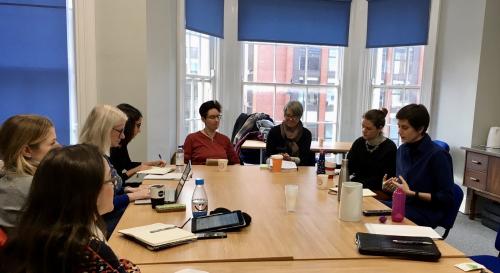
Breadcrumbs navigation
What makes a region and what do regions do? Networks, territoriality, and the emergence of the Amazon region in World Politics
Lucas de Oliveira Paes discusses the key arguments from his Review of International Studies (RIS) article. If you'd like to know more you can read the full article - Networked territoriality: A processual–relational view on the making (and makings) of regions in world politics.
Regions are a pervasive but elusive concept in international relations. Both in academic and general debates, we tend to call regions those territorial units that mismatch state borders, pieces of land or water laying within, across, or above states. Yet, while regions are ultimately territorial demarcations, their boundaries are seldom crisp as those of states. In my RIS article, I propose we can best apprehend regions and how they affect world politics by examining the shifting social relations transformed in the process of defining regional boundaries.
To make sense of this intertwined ‘making’ and ‘makings’ of regions (what makes them and what they do in the world), I recast existing views on the emergence of regions through a processual-relational lens. Previous scholarship has discussed the emergence of regions in two overarching main ways. One is regionalism, which describes political projects of region making. This pathway of region-making tends to be centred on building institutions that embody a region as political arena of governance, defining issues to be governed and specifying who can take part on governing them. Another pathway of region-making in the literature revolves around the notion of regionalisation. This is often manifested in the study of regional integration in terms of increasing socioeconomic flows, cooperation among national and subnational political entities, or sociocultural ties and collective identities.
While much ink has been spilled on specifying causal relations between the more top-down institutional regionalism and the more bottom-up regionalisation, we still lack a theoretical framework to understand and compare the multiple ways in which regionalism and regionalisation relate. The framework that I propose in the article proposes two sets of mechanisms that link these processes. First, bounding mechanisms get at the boundary creation and control that regionalism focuses on. These include striving to monopolise the interaction of a region to the world, representing the region vis-à-vis external actors and, most importantly, defining who is part of the region and can speak on its behalf. Second, binding mechanisms reflect the production of the regional space through the tying of social relations among social and political actors. Bounding mechanisms produce the delimited territorial aspect of region, with an inside and an outside, while binding mechanisms produce the network infrastructure of social relations that allow for a region to be a cohesive grouping. Altogether, the argument goes, regions can be understood as networked territorialities.
This framework allows us to grasp varieties of region-making, without assuming universal models or benchmarks of regional integration. I put this analytical framework to work by examining the emergence of the Amazon as a region in world politics. The Amazon case is interesting for few different reasons. First, the featuring of the region as its own sociopolitical space is relatively recent in world politics. The Amazon was integrated to the modern international order mostly as periphery of colonialism or of the states built through it, not as the centre of any political process. In this sense, the Amazon provides an interesting case of region-making almost anew. Second, and relatedly, the Amazon region has not produced strong shared political identities, high levels of cross-border socioeconomic flows, or robust institutional integration that existing literature would expect of regions, yet, as I argue and show, it still binds and bounds social relations around its governance. Third, and finally, the Amazon case presents a type of region whose study and theorisation are still incipient in world politics, that is, regions anchored in ecosystems with global relevance. Hence, the case has an intrinsic relevance as way to understand how the emergence of the Amazon as a region has shaped the governance of such an important ecosystem.
I approach the emergence of the Amazon region in two ways. First, I discuss the making of the Amazon as region. I investigate how actors involved in Amazon regionalism strived to define and institutionalise regional governance, which social actors are meant to be integrated and who is to be excluded. Second, I examine the makings, or effects of the Amazon as region in world politics. In that sense, I focus on understanding the actual patterns of relations that Amazon regionalism produces beyond the region, more broadly in global governance settings.
In its modern history, the Amazon river basin and rainforest has only recently become conceived of as a cohesive political space. Up until the second half of the 20th century, most political actors would see the region as not one but many regions. Each state with sovereignty over the region’s natural resources would define its own domestic Amazon: i.e. the Brazilian Amazon or the Peruvian Amazon. In this sense, Amazon states sought to extend their presence and control over the ecosystem primarily through linking the region to their economic models of development. This, of course, overlooked the latent territoriality defined by the Amazon extensive biome and the web of relation it weaves among its biodiversity and amongst Indigenous peoples’ homelands. Ironically, it would be this ecosystemic character that would trigger the emergence of the Amazon as a region.
In the 1960s and 1970s, environmental awareness and conservationist concerns were gaining space in international politics, raising the pressure over development models through which Amazon states integrated the region to their national economies. The Amazon Cooperation Treaty (TCA) - which then provided the first institutional arena having the Amazon River basin and rainforest as its main object of governance - was signed in 1978 as a response of Amazon state actors to this growing global awareness of its preservation as an ecosystem. Regionalism was thus a means for Amazon states to defend their monopoly over representing the region vis-à-vis external actors, and to preserve their national borders as the main boundary defining the region. In this sense, the Amazon emerges as a region not to be integrated as one, but to be kept as many, within the jurisdiction of each state.
The Amazon regionalism capacity for bounding without binding would be put the test with the growing environmental degradation that followed the decade after the TCA signature. The colonisation process of the Amazon, particularly in Brazil, was also intensifying conflict over territory. More and more, Indigenous peoples started to have the physical and socio-political integrity of their communities and lands shattered by the incursion of miners and settlers from elsewhere in the countries. The Amazon would become prominent in the worldwide rise of global networks of Indigenous peoples, whose struggle centred on defending their territorial rights. In Brazil, extractive communities that have lived in the rainforest for decades, such as rubber-tappers, also started to see their livelihoods threatened by growing activities such as logging and cattle raising. The murder of environmental activist Chico Mendes brought even greater domestic and international pressure on governments to take action to preserve not only the Amazon environment, but also its inhabitants. Amazon-based local actors were organising themselves, binding the region through their networks, and starting to speak for and on behalf the forest.
The growing international and domestic pressure to conserve the ecosystemic integrity of the Amazon would revive regional cooperation, but with an important twist. Amazon states would again work together to preserve their centrality in the governance of the region, but now recognising its ecosystemic nature and seeking to secure a role of stewards of such a globally significant ecosystem. The Amazon regional cooperation evolved and institutionalised adjacent states’ position as the main stakeholders in the environmental governance of the Amazon ecosystem.
A big part of this process would unfold in global arenas, where Amazon states strived to gatekeep external influence and monopolized representation of the region. To examine these makings - or effects - of the Amazon region in environmental politics, I studied patterns of interactions among state and non-state actors involved in debates about the Amazon in global environmental negotiations. I mapped those interactions through the reports of the Earth Negotiations Bulletin (ENB) produced by the International Institute for Sustainable Development (IISD). These reports describe the proceedings of each day of negotiation across 49 distinct negotiations from 1992 to the present moment, based on a standardised style guide that minimises biases from reporters.
I study these interactions through network analysis, focusing on sets on two sets of indicators: centrality and clustering. Centrality metrics try to describe the most relevant actors in a network, or, in this context, the most relevant actors in the negotiations. Clustering metrics identify groupings in a network, actors who tend to interact more amongst themselves than with others. The most salient aspect of the analysis is the centrality and clustering of the Amazon states in these negotiations. The Amazon states concentrate most interactions with the rest of the network but are even more intensely connected among themselves. The only other dense cluster in the network is the one among other states, mostly from Global North, although with less frequent interactions. Laying in between these clusters, we find nodes that represent the Amazon states collectively. One is the Amazon group, which is how a temporary coalition of Amazon countries is referred to in some ENB reports. The other is the Amazon Cooperation Treaty Organization (ACTO), which seems to bridge interactions of its member states with several other intergovernmental organisations. In both cases, positions seem to reflect the joint action of Amazon states when interacting with other states.
The other Amazon actors are more sparsely distributed in the network. Most nongovernmental organisations have only one tie. The main exceptions are the indigenous organisations, two of which stand out. One is the Coordinator of the Indigenous Organizations of the Amazon River Basin (COICA), an institution that represents indigenous peoples from the entire region. Although peripheral to the overall network structure, COICA has interactions with multiple actors, most of them being international governmental organisations. The second node that stands out is Amazon indigenous groups, which captures references to indigenous peoples where no specific organisation is specified. It is interesting to note that these references are mostly used to describe interactions with organisations from civil society or with the Amazon states themselves. In this sense, the Amazon states seem to gatekeep the interactions between indigenous peoples organisations and other local actors from the Amazon with other actors in relevant global governance fields. Therefore, Amazon states concentrate the interactions in the network, while keeping denser ties among themselves than with other actors. Overall, the analysis of this network of interactions in the environmental negotiations involving the Amazon helps illustrate the effects of the region on world politics. The binding of the Amazon’s adjacent states allows for defining and preserving the boundaries of the region in global governance.
In summary, the processual–relational perspective presented in the article and exemplified in the Amazon case expands our understanding of what makes regions and what regions do in world politics. It allows us to go beyond the traditional views of regionalism and regionalisation centred on institutional and socioeconomic integration, along with their often-Eurocentric benchmarks. In turn, it shifts our attention towards studying the making of regions through their effects on world politics: the patterns of relations it produces and the boundaries it raises. Furthermore, it offers a methodology to empirically study these relations in process. Therefore, it opens the way for studying consequential aspects in the making and makings of regions that could have otherwise gone unnoticed, as the case of the Amazon illustrates.
Want to know more? You can read Lucas' full article at DOI: https://doi.org/10.1017/S0260210522000249
This particular article is open access, however BISA members receive access to RIS (and to our other journal European Journal of International Security) as a benefit of membership. To gain access, log in to your BISA account and scroll down to the 'Membership benefits' section. If you're not yet a member join today.
Photo by Andrew Coelho on Unsplash


